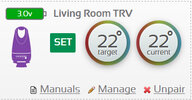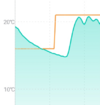Still struggling with this. Am I right in thinking if I close both valves on the radiator - turn heating on - ope both valves - the one that heats up first is the flow? Because on most of them this is the valve with the small cap and not the turn valve which I initially thought controlled the flow and was set to 100% open.
In this case if it doesn't matter should I simply turn both of them 1/4 turn and adjust whichever one I like to get the 12 degrees?
Also, as the rads take so long to heat up it's proving very difficult to pinpoint the first radiator, they all seem to heat up roughly the same time.
In this case if it doesn't matter should I simply turn both of them 1/4 turn and adjust whichever one I like to get the 12 degrees?
Also, as the rads take so long to heat up it's proving very difficult to pinpoint the first radiator, they all seem to heat up roughly the same time.



